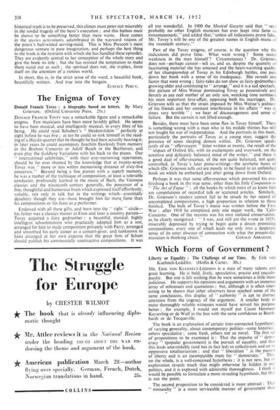Tudor Yorkshire
IN the past Miss Prescott has been novelist, historian, translator—and, in all three kinds, an artist in words. Now she has focused her gifts on the writing of the almost perfect historical novel—perfect, because it uses exact research for the known, frank invention for the unknown, and a scholar's informed imagination to give coherence to the whole.
But a historical novel in two volumes and more than 300,000 words—is not that rather much for a public which has forgotten how to read John Inglesant or Waverley? Especially as its theme is a relatively minor event in Tudor history : the dissolution of the Yorkshire monasteries and the abortive Pilgrimage of Grace, with, for hero, the obscure, though historical, figure of Robert Aske. No doubt Miss Prescott would be little disturbed by that criticism, for the making of this book has been so clearly a labour of love, long worked over and packed with all that she has learnt from books and from local study of her Yorkshire scene, and all, too, that she has dreamt of the meaning of her story sub specie aeternitatis. Still, even a labour of love must have proportion. Was it necessary to embroider in such detail a background from which the main theme detaches itself so slowly : not only the life of a little Swaledale nunnery and of neighbouring Yorkshire manors, but also a whole London panorama of Henry VIII, Catherine and Anne Boleyn, Cromwell, Norfolk and More ? Was it necessary to give the hero an imaginary shy girl adorer, and then to endow her, in turn, with a not entirely imaginary siren sister, and thus to start a whole side-plot ? Was it necessary to add another elaborate portrait of an unworthy priest turning Lutheran, with his own background of hole-and- corner heresy ? " There's richness," indeed, but are not the riches spilt a little extravagantly ?
On the whole, the answer, one thinks, is that the proportion is right, after all. In spite of its length, the book is easy to read. For the most part the story is told episodically, in the form of a chronicle, so that the crowding actors can be marshalled into their places scene by scene. There is, too, a cameo-like vividness in the scenes which sticks in the memory. Much, again, of the essential stiffening of historical fact, political and social, is necessarily in the background. And the suspicion of superfluity fades as, at last, the story draws to its climax in the portrait of a reluctant rebel, who takes his decision on grounds that the earlier " build-up " has shown to be just, if only just, sufficient ; and then finds himself the only honest man of action among a crowd of half-hearted gentry, leading, and half betraying, a genuine revolt of the " commons." Moreover, if historical truth is to be preserved, this climax must peter out miserably in the sordid tragedy of the hero's execution ; and this bathos must be shown to be something better than mere waste. Here comes in the species aeternitatis, adumbrated in the wayward visions of the priest's half-witted serving-maid. This is Miss Prescott's most dangerous venture in pure imagination, and perhaps the best thing in the book is the restraint with which she has handled these episodes. They are evidently central to her conception of the whole story and give the book its title ; but she has resisted the temptation to make them stand out as such ; the spiritual does not, she implies, force itself on the attention of a riotous world.
In short, this is, in the strict sense of the word, a beautiful book, beautifully written. And true into the bargain.
EUSTACE PERCY.











































 Previous page
Previous page